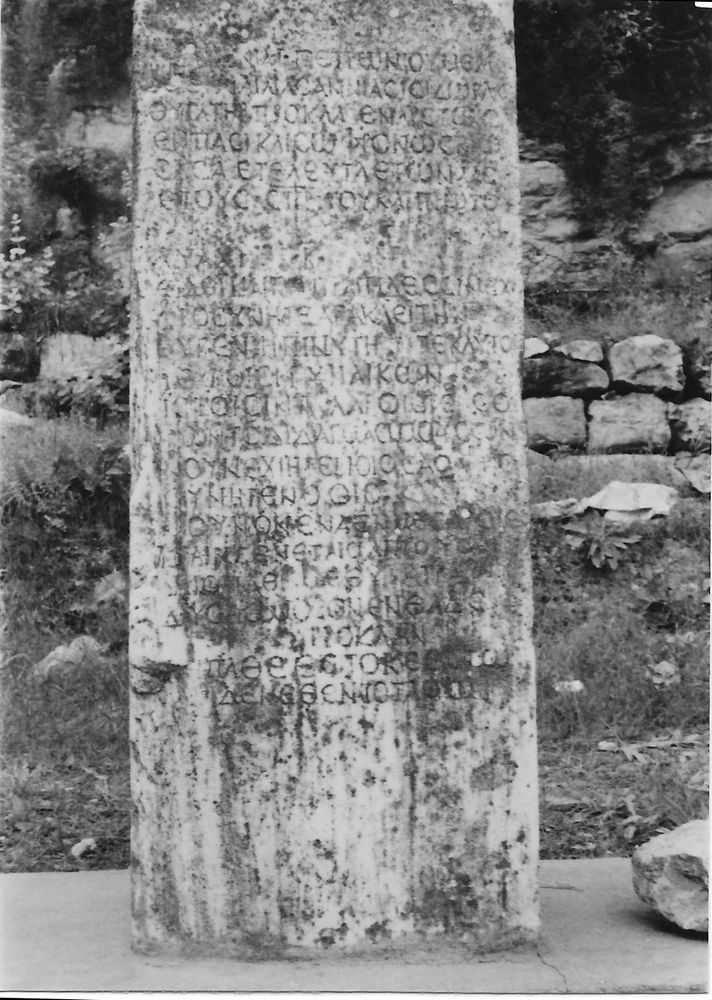Support: White marble stele slightly tapering, chipped off above, where a moulding is probably lost and at left lower angle
of front face
(w: 0.42 to 0.465 × h: 1.19 × d: 0.275 to 0.36).
Layout: Inscribed on front face, which is the back of the former IGCyr1023002;
spaces at ll. 1, 9 and 11 are due to some irregularities on the surface.
Letters: 0.023; serifs; lunate epsilon and sigma, cursive mu and omega, alpha and lambda with projecting right hasta.
Date: Between september 251 and spring 252 AD (internal date, reign, lettering).
Findspot: Found at Cyrene ➚
before 1938 (see commentary); findspot unrecorded, but surely from some part of the
Necropolis.
Place of origin: Findspot.
Last recorded location:
Seen by C. Dobias-Lalou many times, namely in 1976, 1982 and 2010 in Shahat: on the
Terrace of the Department of Antiquities.
Text constituted from: Transcription from stone (CDL).
French translation
Petronia, fille de Gaios Petronios Melior et d'Ailia Annia Isidora, Prokla, ayant vécu vertueusement à tous égards et sagement,
est décédée à l'âge de 45 ans, l'an 282 qui est aussi le premier de ⟦l'empereur Gaius Vibius Trébonien Galle⟧ le 2 Khoiak.
Bien connue pour ma beauté, mon intelligence et ma bonne humeur,
ma bonne naissance et ma retenue, réputée pour mes travaux féminins,
ceux des métiers et des corbeilles, et pour les leçons des savantes Muses,
pour la discrétion de ma vie et la sagesse de mes pensées,
ne laissant plus à mes parents qu'un seul enfant en leur demeure,
c'est moi la malheureuse Prokla, leur fille infortunée,
que mes parents, résistant au chagrin, ont ici placée en ce tombeau.
English translation
Petronia, daughter of Gaios Petronios Melior and of Ailia Annia Isidora, Prokla, having lived with overall virtue and wisdom,
deceded at age 45, in the year 282, which is also the first of ⟦Emperor Gaius Vibius Trebonianus Gallus⟧ on Choiak 2nd.
Well known for my beauty and understanding, my high spirits,
noble birth and wisdom, famous for my women's works,
those of looms and baskets, and for the lessons of the clever Muses,
for the reserve of my life and the wisdom of my thoughts,
leaving to my parents but one child in their home,
I, ill-fated Prokla, their awfully suffering daughter,
was put into this tomb by my enduring parents.
Italian translation
Petronia, figlia di Gaios Petronios Melior e di Ailia Annia Isidora, Prokla, avendo vissuto virtuosamente in tutto e saggiamente,
morì all'età di 45 anni, nell'anno 282, che è anche il primo dell'⟦imperatore Gaio Vibio Treboniano Gallo⟧ il 2 di Choiak.
Rinomata per la mia bellezza, l'intelligenza e il buon umore,
per la mia nobile nascita e saggezza, famosa per i lavori femminili,
quelli dei telai e dei panieri, e per le lezioni delle Muse sapienti,
per la prudenza della mia vita e la saggezza dei miei pensieri,
lasciando ai genitori un solo figlio nella loro casa,
sono io, sventurata Prokla, figlia molto infelice,
che i genitori, forti nel dolore, qui posero in questa tomba.



